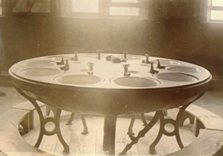Crossley and Porter School History
The Crossley Heath school building owes its existence to the philanthropy of the Crossley brothers , Francis, John and Joseph. In 1857, they formulated a scheme for the establishment of a ‘superior College for the district’. Building work began the same year but by 1861 the brothers had decided to establish an ‘Orphan Home and School for Boys and Girls’. With the building work complete, the first six orphans, all boys, arrived in June 1864, although there was no official opening ceremony and much internal furnishing work remained to be completed. The first boy to be admitted was James Labron Plint.
The Orphanage was built on John Crossley’s land, ‘eight acres, two roods and eight perches’ at the top (west) end of Skircoat Moor, later Savile Park. The architect was John Hogg of Halifax and construction cost around £56,000. A ‘quadrilateral stone structure of the architecture of the reign of King James I with a mixture of the Italian style’, it had a planned capacity for 400 orphans with classrooms and dormitories, together with dining and washing facilities etc. Behind the main building were separate playrooms and swimming baths for boys and girls, as well as ancillary buildings such as the laundry. Around 1883, a two-storey extension was built for the girls’ Headmistress. Further land, on the southwest side, was purchased for £1381 in 1892, in order to provide an uninterrupted view across the Calder valley to the moors beyond.
The Deed of Foundation was granted a Royal Charter of Incorporation in September 1868. Its 53 ‘articles’ stipulated precisely how the Orphanage was to be run by a governing body consisting of three Crossley family governors and 15 elected governors. Halifax Borough Council elected three of the latter, while various independent non-conformist churches throughout the former West Riding of Yorkshire elected the other 12. A large endowment fund provided an annual income, which financed the running costs of the Orphanage. The size of the fund effectively determined the number of orphans who could be admitted. Donations and subscriptions, including £100 per annum from the industrialist Sir Titus Salt, swelled the endowment fund. By 1874, there were around 250 orphans from all parts of the country, with only 20% from Halifax itself. Many paid fees, up to a maximum of £10 per annum. In summer, Annual Meetings were held to discuss Orphanage business, published in an official report.
The school year, consisting of two long terms, ran from January to December, with four weeks of vacation in summer and two at Christmas, an Easter break being introduced later. Orphans could be visited for two (later three) hours on the first Tuesday of each month. There was a small resident teaching staff, headed by the Principal. Between late 1864 and early 1910, there were only two Principals, Mr.Oliver and Mr.Barber. A much larger domestic staff, numbered over 30 by 1900. The traditional subjects of scripture, reading, writing and arithmetic were emphasised, although all orphans were also taught geography, drawing, basic natural science and singing. More capable boys were additionally taught Latin, one modern language and more advanced arithmetic, algebra and geometry. At first, girls’ education concentrated on needlework and ‘useful departments of household service’.
Prior to 1870, education in Britain had been entrusted largely to family and church. That year’s Elementary Education Act introduced limited state influence and in 1871, Mr.J.C.Curtis, Principal of the Training College, Borough Road, London, began annual inspections of the school, stimulating a marked improvement in educational standards within the Orphanage. Cambridge Local examinations were introduced in December 1876. In 1877, with more academic subjects available to them, the girls got their own headmistress. There were now effectively two separate schools in one building, the girls’ school occupying the southwest side of the building, facing Skircoat Moor Road, and the boys’ school the other half.
Departing orphans made their way to all parts of the country, and eventually the world. Such was their fondness for their alma mater that when the Governors first invited old scholars to attend their Annual Meeting in 1874, no fewer than 90 responded, starting a tradition of regular reunions which continues today. Sixteen reunions had taken place when, in 1900, the Old Boys’ Association was formed, followed some years later by an old girls’ equivalent, a merger in 1920 creating the Old Scholars’ Association, which remains active today.
In 1887, Thomas Porter, a Manchester yarn merchant, made an endowment of £50,007, on condition that the institution be renamed ‘The Crossley and Porter Orphan Home and School’, as approved by supplemental Royal Charter. The extra funding allowed orphan numbers to remain between 240 and 265 until the First World War and also facilitated the purchase of land opposite the southwest façade and a nearby site, where a sanatorium was built. Scholarships to Bradford Grammar School were introduced, academic standards contining to improve into the twentieth century.
In 1899, the Board of Education was established and in February 1903 it recognised the combined school as an ‘efficient secondary school’. However, annual deficits were incurred from 1901 to 1904, partly because of the higher salaries of better-qualified teachers. General subscriptions fell over 85% between 1881 and 1901 and the Governors were under pressure to make improvements at the Board’s request. Staff cuts restored the financial situation temporarily but the monetary pressures of the next two decades would threaten the very existence of the Orphanage. Its golden jubilee was, nevertheless, celebrated in a spirit of optimism over three days at Whitsuntide 1914, coinciding with the twenty-second old scholars’ reunion.
At the Golden Jubilee celebrations in June 1914, the schools were looking forward optimistically, with new classrooms being opened and science laboratories planned. The Old Boys’ Association had donated new playing fields at Broomfield. In the summer, extensive improvements to the heating, lighting and sanitation delayed the start of term until October. However, with the onset of war everyday costs escalated, subscriptions dropped again and annual deficits of around £1,000 became the norm. The Governors decided neither to decrease numbers nor to increase fees, to spare orphans and their families further hardship, and Francis Crossley’s son, Sir Savile Brinton Crossley, Lord Somerleyton from 1916, pledged an extra £650 per annum from the Crossley family.
Following the 1918 Education Act, the schools became recognised grant-earning schools, renamed the ‘Crossley and Porter Schools, Halifax’, as approved by the Board of Education and confirmed by Act of Parliament in 1919. The governing body now comprised four Foundation Governors and 15 Representative Governors, the latter including five elected by Halifax Council and several more elected by Yorkshire municipal councils. The 1918 Act had raised school leaving age to 14 and the Governors planned to provide education up to age 18. Fee-paying day pupils were admitted for the first time, 175 attending daily by 1925, the number of boarders having declined to just 105.
Nevertheless, the deficit exceeded £16,000 in 1922, despite an increase in boarders’ fees to £40. A Diamond Jubilee Festival was planned, with the sole objective of clearing the debt. All connected with the schools, staff, pupils, old scholars, local businesses and individuals, rose magnificently to the appeal for funds. Saleof the sanatorium realised £3010, planned improvements were postponed and the four-day Festival in July/August 1924 brought the appeal to a successful close, the debt being cleared by the year’s end. In response to this, Mr John William Standeven gave an endowment of £10,000, in memory of his late wife, Mary Ann. Income from the endowment was used to lower boarders’ fees.
Ironically, as the country headed toward industrial strife and the Depression, the schools entered a relatively prosperous period. Two new wings were constructed, along with fives courts and a manual workshop. The girls began cookery, laundry, pottery and gardening. Mr Newport and Miss Dale had divided both schools into Houses and inter-House sporting competitions flourished. By 1930, both schools had small sixth forms, studying for the Higher School Certificate. A growing number of school societies catered for extra-curricular interests. Scout, cub, guide and brownie groups were formed. Overall physical fitness was improved by the introduction of twice-weekly compulsory games for all boys. A doctor oversaw general health and a dentist visited every fortnight. By summer 1939, 3036 boarders, 1975 boys and 1061 girls, had been admitted since 1864.
The Second World War again disrupted school life. As during the Great War, male staff joined the armed forces and boarders were evacuated to local families. Remaining male staff became air wardens and special constables and a school cadet force was established. As with many schools and colleges throughout the country, Crossleys shared its premises. Whitelands Training College for Elementary School Teachers took over the top two floors of the school as as a hostel for its first year students. The 1944 Act abolished the Board of Education, designated a Minister of Education to oversee local education authorities (LEA) and made secondary education compulsory. The schools became voluntary controlled secondary (grammar) schools, with a governing body consisting of five Foundation Governors and 10 Representative Governors, the latter appointed by the LEA. This arrangement abolished junior sections and fees, the junior section duly closing in 1947, with boarding in the main school building being officially discontinued. The Parents’ Association had been formed in the uncertain climate of 1945 and over subsequent decades it provided a valuable social and fund-raising support for the school.
In 1948, with the family’s agreement, the Standeven endowment was used to purchase two new hostels for boarders near Broomfield. The former ‘Ravenswood’ was renamed ‘Standeven House’ in memory of Mrs Standeven. It could accommodate 16 boys and nearby Crossley House (formerly ‘The Gleddings’) had room for 16 girls. The hostels never reached full capacity and closed in 1961, when the last boarders left. ‘The Gleddings’ was sold and Standeven House was converted for use as a pavilion by the Old Scholars’ Association, whose members had extended and developed the adjacent playing fields.
Still with separate Heads, the boys’ and girls’ schools celebrated their centenary together in 1964 and, with everyday co-operation increasing, they were officially merged, under one Head, on 1 January 1968. Changes in society in general and education in particular affected the grammar school, although it survived the move toward comprehensive education. However, falling school rolls and limits on public finance highlighted an over provision of grammar school places in Calderdale. Accordingly, in 1985 the Crossley and Porter School was merged with Heath to form the Crossley Heath School.












